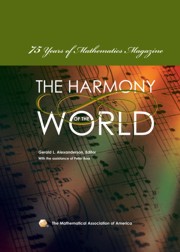Book contents
- Frontmatter
- Introduction
- Contents
- A Brief History of Mathematics Magazine
- Part I The First Fifteen Years
- Part II The 1940s
- The Generalized Weierstrass Approximation Theorem
- Hypatia of Alexandria
- Gauss and the Early Development of Algebraic Numbers
- Part III The 1950s
- Part IV The 1960s
- Part V The 1970s
- Part VI The 1980s
- Briefly Noted
- The Problem Section
- Index
- About the Editors
Gauss and the Early Development of Algebraic Numbers
from Part II - The 1940s
- Frontmatter
- Introduction
- Contents
- A Brief History of Mathematics Magazine
- Part I The First Fifteen Years
- Part II The 1940s
- The Generalized Weierstrass Approximation Theorem
- Hypatia of Alexandria
- Gauss and the Early Development of Algebraic Numbers
- Part III The 1950s
- Part IV The 1960s
- Part V The 1970s
- Part VI The 1980s
- Briefly Noted
- The Problem Section
- Index
- About the Editors
Summary
Editors' Note: Eric Temple Bell is largely known today for his popular works—Men of Mathematics, Mathematics: Queen and Servant of Science, The Last Problem, Numerology, The Search for Truth, among others–and perhaps even for his science fiction, published under the pseudonym of John Taine. He was nevertheless a serious mathematician. Constance Reid, his biographer, notes that Bell's bibliography, including his mathematical papers, general articles, and reviews, runs to over three hundred items.
Bell took his PhD at Columbia, after receiving a master's at the University of Washington. He spent only twelve months at Columbia working on his doctorate and wrote a dissertation on cyclotomy, extending some work of Eisenstein. The identity of his dissertation advisor at Columbia remains a mystery, even after extensive inquiries and interviews with those who knew Bell. The best conjecture is that his advisor was Frank Nelson Cole, the number theorist at Columbia for whom the Cole Prize of the American Mathematical Society is named. Others conjecture that it was the department head, C. J. Keyser. Unfortunately the dissertation was not signed by an advisor and documents at Columbia have the relevant lines left blank. It's one of many “mysteries” in Bell's life—one still remaining after the extraordinary sleuthing done by Reid when she wrote his biography (The Search for E. T. Bell, MAA, 1993).
In 1940 Bell wrote a more scholarly and detailed history than Men of Mathematics, his Development of Mathematics, still a valuable reference.
- Type
- Chapter
- Information
- Harmony of the World75 Years of Mathematics Magazine, pp. 51 - 68Publisher: Mathematical Association of AmericaPrint publication year: 2007

